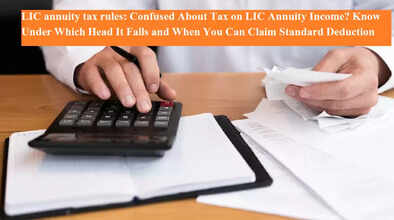LIC annuity tax rules: Confused About Tax on LIC Annuity Income? Know Under Which Head It Falls and When You Can Claim Standard Deduction

Many taxpayers are often uncertain about how the income received from an annuity — such as the one offered by the Life Insurance Corporation of India (LIC) — is taxed. One such case is that of Manoj Sharma from Noida, who receives ₹10,122 per month as annuity from LIC. His annuity was purchased using funds received at the time of retirement from his employer. He wants to know under which head this income is taxable and whether he is eligible to claim a standard deduction.
To clear this confusion, Moneycontrol consulted tax expert CA and CFP Balwant Jain, who explained how annuity income is treated under the Income Tax Act.
Taxability of LIC Annuity Income Purchased by Employer Funds
According to Balwant Jain, if an annuity has been purchased by the employer using the employee’s retirement benefits (for example, gratuity or provident fund), the monthly pension received from such an annuity is treated as “salary income.”
This means that it will be taxed under the head ‘Income from Salary’ in the same way as a regular pension or salary income.
The taxpayer can also claim the standard deduction available to salaried individuals. Under the old tax regime, the standard deduction amount is ₹50,000 per financial year. However, under the new tax regime, this deduction has been increased to ₹75,000.
This standard deduction is available irrespective of whether the salary (or pension) pertains to arrears, advance, or the current financial year.
Therefore, in the case of Manoj Sharma, the ₹10,122 he receives every month from LIC as an annuity purchased by his employer’s retirement fund will be taxed under the head “Salaries.” He can claim the applicable standard deduction depending on the regime he opts for.
Tax Rules for Annuities Purchased with Personal Funds
Jain further clarified that the taxation differs when the annuity has been purchased by the individual himself using personal funds rather than by the employer.
If the annuity is bought personally — for instance, using one’s savings or investments — the monthly payments received are not treated as salary. Instead, this income will be taxable under the head “Income from Other Sources.”
In such cases, the taxpayer cannot claim the standard deduction of ₹50,000 (old regime) or ₹75,000 (new regime), since this benefit is available only for income taxable under the “Salaries” head.
Summary of Key Tax Rules on Annuity Income
| Type of Annuity | Tax Head | Eligible for Standard Deduction |
|---|---|---|
| Purchased by Employer from Retirement Benefits | Salary Income | Yes (₹50,000 in old regime / ₹75,000 in new regime) |
| Purchased Personally (Using Own Money) | Income from Other Sources | No |
Why It Matters for Retirees
This clarification is crucial for retirees, especially those receiving monthly income from annuity plans. Understanding whether the annuity was purchased by the employer or personally helps determine the correct tax treatment and deduction eligibility.
Incorrectly classifying this income could lead to filing errors or missed tax benefits. With the standard deduction providing a direct reduction in taxable income, it’s an important consideration when choosing between the old and new tax regimes.
Expert Takeaway
Tax expert Balwant Jain emphasizes that retirees must carefully check the source of their annuity before filing income tax returns. If the annuity was purchased by the employer as part of a retirement benefit, it should be treated as salary income, and the taxpayer can claim the standard deduction. However, if it was purchased personally, it will be treated as income from other sources, and no deduction will apply.
Hence, Manoj Sharma — and others receiving similar annuity payments — must pay tax on the LIC annuity under the “Salary” head and can claim the standard deduction as per the regime chosen.

